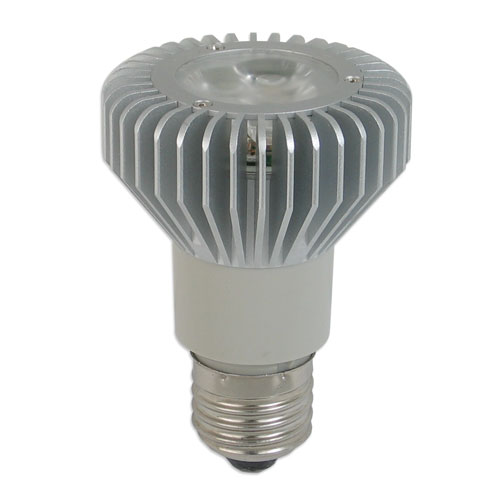
Thomas Edison…It was nice knowing you, but the days of the incandescent light bulb are numbered! Ok, so here’s my scenario. I’m definitely not your classic Al Gore save the spotted clam type. So when I tell my friends about this purchase, at first they don’t get it.
I often work out of a home office that is about 12 feet by 12 feet and is located in my basement. Due to that, it is a naturally cool area to work. We do have air conditioning that was piped in from the main system via a thermostatically controlled gate so during very long hot spells in the summer, it can be cooled from about 75 which is the norm in July down to my preferred 72.
However, in this office, I have an AMD 4400 based PC, a Core 2 Duo 3ghz Hackintosh (just using for learning purposes:), a Xerox Phaser Printer that melts wax as its mode of printing, a Core 2 Duo laptop, my wife’s AMD 3800 based PC, and 10 50watt PAR20 Halogen light bulbs to light the place up.
With the door closed (4 boys under the age of 8 are home during the summer) and all equipment on, within about 20 minutes, well let’s just say, working in your shorts isn’t just a figure of speech.
So, since my wife is rarely in the room during the workday, I keep her PC in standby, I try and keep the printer (which runs very hot when ready) in stand by, and I keep only half the lights on. Let’s say, it’s “bearable” this way and somewhat dark.
When my AMD 4400 hits it’s 3 year anniversary this December, I’m replacing it with another Core 2 Duo. It’s absolutely amazing how much cooler (and faster) the new 45nm core 2 duo chips are compared to the older AMD X2 chips.
But for now, I’ve discovered the ultimate solution that doesn’t require me cooling a 1200 sq foot basement for 8 hours just to keep me from melting.
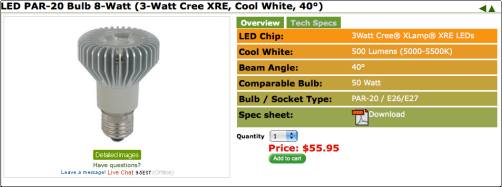
LED Light Bulbs.
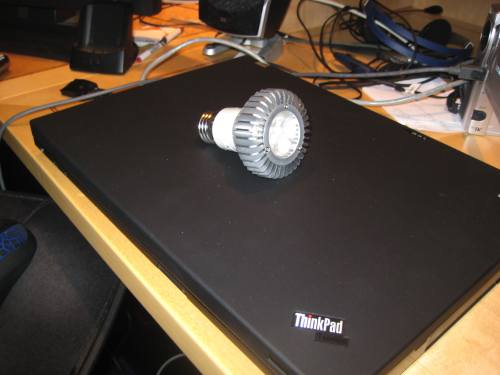
I purchased one from www.ledwaves.com.
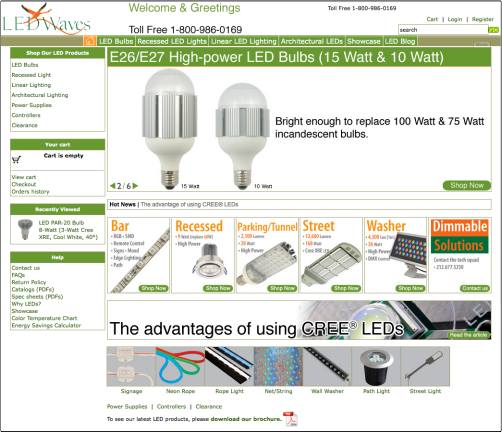
It was the most compatible and least expensive I could find for my needs. They carry a very broad variety of LED lights, and the one I needed was a PAR20 120v 50 watt bulb replacement.
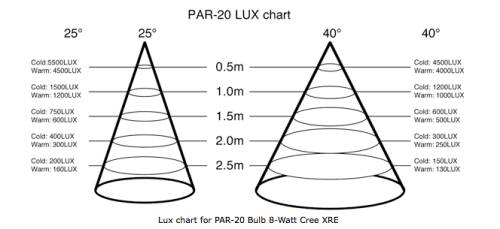
Yes, they do make CFL (Compact Fluorescent Lights) in this size. However, CFL lights put out odd “colors”, use about twice as much power and have a life of about 6000 hours. They cost about $15/each. CFL’s have a lot of downsides though. In this size, they use about 14 watts. A lot less than the 50 on the halogen, but almost double the 8 of the LED. CFL’s have mercury in them which makes disposal (or breakage) very hazardous. Many (not all) CFL’s take a couple of seconds to turn on when you hit the switch and many take as much as a minute to reach full brightness.

Not a big deal in a room in which you leave the light on all day, but for an on/off scenario like a hallway, its really annoying. CFL’s also put out a very “harsh” light that can appear to flicker at 60hz (or 50hz if your in Europe).
Using new coatings, this doesn’t seem as bad as traditional office florescent lights, but still noticeably different light from the halogen. You won’t find any jewelry stores using CFL’s in their display cases, that’s for sure. In addition, all florescent lights have a ballast that can wreak havoc with electronic signals that run over power lines like X10, Ethernet over Powerline devices (such as LukWerks cameras), and audio equipment (hum…)
Traditional Halogen’s that I’m replacing are about $10/each and claim 4000 hour life but I’m seeing about half that at best.
This LED bulb, claims a 50,000 hour life (love to know how they test this since this technology is only a year or two old.) So theoretically I won’t need to replace this bulb until my 6 month old baby is graduating high school assuming I leave the bulb on 365 days/year 8 hours a day.
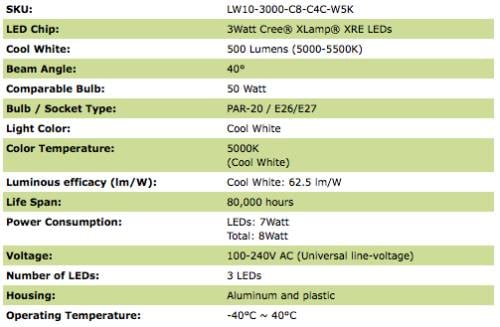
The amazing part is you could almost light a cigarette on the traditional halogen.
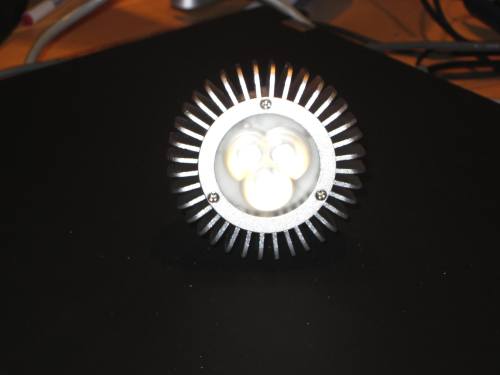
Touching this LED bulb after it being on for an hour and you really have to concentrate to notice it is a few degrees warmer than the ambient room temperature.
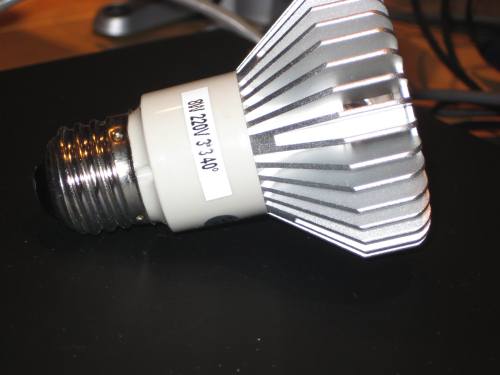
It consumes 8 watts of electricity versus 50 watts for about the same light on the Halogen. The light it throws is pretty much identical to the Halogen. This is why jewelers are starting to use these bulbs. Heat buildup is a huge problem in display cases, a the difficulty of changing bulbs is also a problem. Using these, a chain can install them and not worry about high maintenance costs in staff to replace low voltage halogens (which need to be handled very carefully in order to avoid possible rupture). When a bulb blows, you have to turn off the whole display and wait about 30 minutes for things to cool down enough to handle. Not great in a retail environment.
Ledwaves.com has an interesting ROI calculator on their site that takes into account halogen bulb replacement, electricity, and time value of what it’s worth getting a ladder out (9 foot ceilings) to change the bulbs. With 10 bulbs in the room, this seems to happen about every 2 to 4 weeks at the worst time).
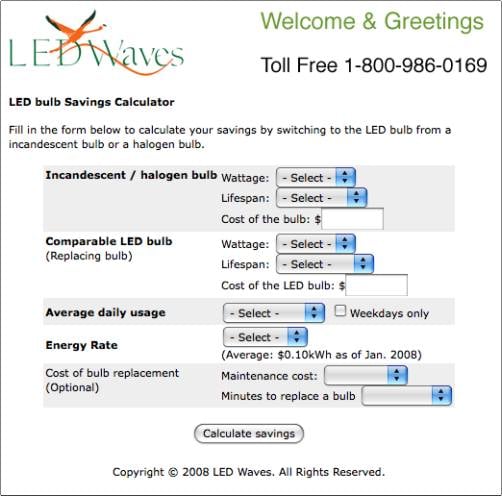
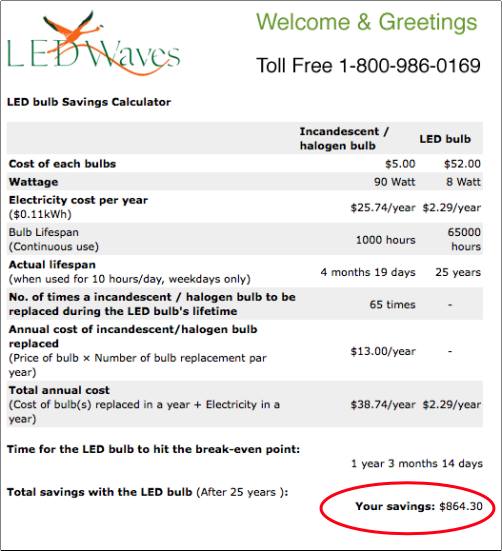
The bulbs currently cost $55 with a 5 unit minimum purchase. This works out to an ROI of about 11 months. This does NOT take into account the SIGNIFICANT reduction in heat which in the summer allows your air conditioner to work much less. The air conditioner draws massively more power than any of the bulbs.
My guess is either financially minded people like myself, or environomentaly conscious people will start snapping these up. The masses probably won’t when it costs more than 5x as much as a conventional bulb. However, recent breakthroughs claim they will be able to manufacture these for half the cost in less than 2 years. When they hit about $25, I think you will see a mass exodus from Thomas Edison.
LED PAR-20 Bulb – 8-Watt
Cost – $ 55 per bulb
What I liked:
– Significantly lowered room temperature compared to halogen lighting
– Cool to touch
– Longer life (advertised)
What could be improved:
– Costly
LED Waves – PAR-20 Bulbs

A very interesting article. I will check these out when I move to the US in December.
This is such a huge improvement, but I can’t see it taking off until the pricepoint is a lot lower, say in the sub-$20 range. Personally, I will find it difficult running around fronting $50 + per bulb even if there’s a future savings. It’s the up-front costs that always get you.
I guess I’ll just have to replace them as the old ones (mostly CFLs these days) fail and the funds become available!
I work in the lighting department at home depot. The LED lights are many times better than the halogens, although we don’t carry the PAR 20 equivalents, only the GU10, I’m hoping the price goes down soon, I’d like to convert everything over.
These lamps have a hell of a lot of proving to do. Remember, the CFL was supposed to replace the incandescent, and has failed utterly to do so in my situations. New England outdoor temperatures has stalled every CFL I’ve used from lighting when the temperature falls below +10F. Next, I’ve not seen a CFL which can be totally enclosed, not seen a CFL that lets you burn with the screw bas above the glow tubes. Lastly, CFLs need warm up times of several seconds to several minutes. Incandescent STILL has those sockets in my house. My kitchen CFL fixture is barely 2 years old, was purchased to replace ancient round Fluorescents, but I’ve already burned out the 2 bulbs it came with. My insistence is that the ratings for CFLs are based on perfect conditions, and the ratings fall of precipitously as you move from ideal (orientation, temperature). So, having suffered the utterly failed promises of CFL, I have tried a few LED lamps. So far, so very good, but I need 5 more years without a failure before I post that I accept that LEDs have properly replaced incandescent. That’s the lesson CFL taught,
Your external CFLs don’t light under 10F? I am very surprised … we (west-central NY) have had temps to -5F (wind chill below -20F) in the last few weeks and all of our outdoor lights have worked just fine. I wonder if your voltage is on the low side? Could be insufficient to ignite? Not really sure …
We are entirely CFL in our house – but the crap the builder used all failed within the first few years as well. Spending a few $ more we got reliable bulbs and haven’t replaced them since.
As for LEDs, we have been slow to replace due to pricing as well.
Nope, I’ve tried 3 CFL brands (Philips, Lights of America, Sylvania), in multiple outdoor fixtures, my experience is that they just won’t strike in common winter temps. As for my line voltage, I have 129 volts AC, as measured by an inexpensive Kill-a-Watt power meter; and years ago, a different voltmeter (Data Precision 2480R, true RMS laboratory multimeter) which I borrowed from my employer displayed 127VAC. Definitely not low powerline voltage; some might feel the voltage here is too high.
My voltage at that location was on the high side, 127-129 VRMS.
Returning after 9 years….
CFL’s are only in the sockets because they continue to light up. When CFL’s fail, LED’s get the socket. Today, even $1 LED lamps from dollar stores are better than all other lamps. Currently, though, it is very difficult to find LED’s with light output comparable with either 75W or 100W incandescents. I see 40W LED’s and 60W LED’s pretty much all the time. And someday, we need to switch our thinking to luminosity values over incandescent watts.